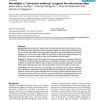Free Online Productivity Tools
i2Speak
i2Symbol
i2OCR
iTex2Img
iWeb2Print
iWeb2Shot
i2Type
iPdf2Split
iPdf2Merge
i2Bopomofo
i2Arabic
i2Style
i2Image
i2PDF
iLatex2Rtf
Sci2ools
BMCBI
2005
2005
Harshlight: a "corrective make-up" program for microarray chips
Background: Microscopists are familiar with many blemishes that fluorescence images can have due to dust and debris, glass flaws, uneven distribution of fluids or surface coatings, etc. Microarray scans do show similar artifacts, which might affect subsequent analysis. Although all but the starkest blemishes are hard to find by the unaided eye, particularly in high-density oligonucleotide arrays (HDONAs), few tools are available to help with the detection of those defects. Results: We develop a novel tool, Harshlight, for the automatic detection and masking of blemishes in HDONA microarray chips. Harshlight uses a combination of statistic and image processing methods to identify three different types of defects: localized blemishes affecting a few probes, diffuse defects affecting larger areas, and extended defects which may invalidate an entire chip. Conclusion: We demonstrate the use of Harshlight can materially improve analysis of HDONA chips, especially for experiments with subtle...
BMCBI 2005 | Chip | Image | Starkest Blemishes |
| Added | 15 Dec 2010 |
| Updated | 15 Dec 2010 |
| Type | Journal |
| Year | 2005 |
| Where | BMCBI |
| Authors | Mayte Suárez-Fariñas, Maurizio Pellegrino, Knut M. Wittkowski, Marcelo O. Magnasco |
Comments (0)

